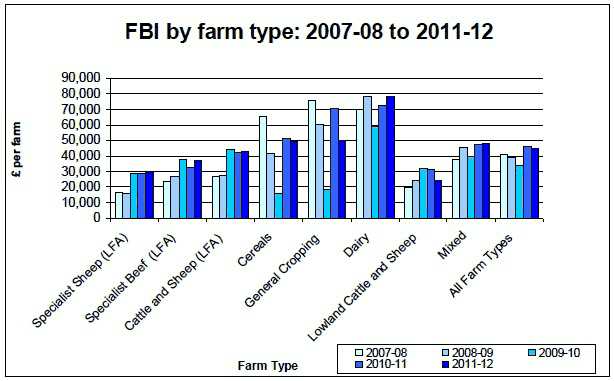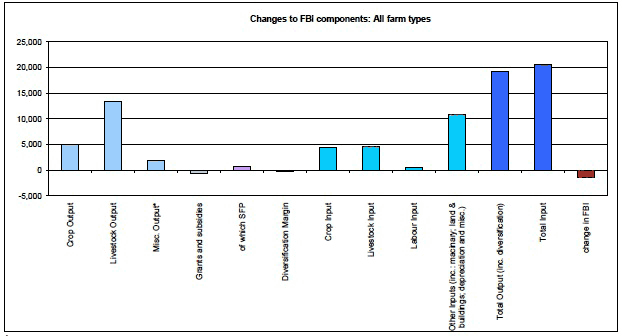Scottish farm business income: annual estimates 2011-2012
Estimates of Total Income from Farming for 2011, inital estimates for 2012 and Farm Business Income estimates for 2011-12. For the most recent data, visit the Scottish farm business income (FBI) collection page below.
This document is part of a collection
4 Commentary : Farm Business Income (FBI)
4.1 Background on FBI and comparisons with TIFF
Estimates of Farm Business Income (FBI) come from the Farm Accounts Survey (FAS) for Scotland, which is based on a sample of 502 farms in 2011-12 and 501 farms in 2010-11. The survey only includes farms above a certain size (over and above 0.5 Standard Labour Requirements) and covers most main farm types in Scotland, excluding horticulture, specialist pig and specialist poultry producers.
FBI represents the return to all unpaid labour (farmer, spouse and others with an entrepreneurial interest in the farm business) and to their capital invested in the farm business, which includes land and buildings. FBI is equivalent to financial Net Profit although, in practice, they differ because Net Profit is derived from financial accounting principles whereas FBI is derived from management accounting principles. For example, in financial accounting output stocks are usually valued at cost of production whereas, in management accounting, they are usually valued at market price. In financial accounting depreciation is usually calculated at historic cost whereas in management accounting it is often calculated at replacement cost. The FBI measure is designed to capture the return to the entire farm business and therefore also includes income from diversified activities on the farm.
The FBI measure is closely aligned to TIFF, although there are some key differences, which are described in the Introduction section of this publication. Chart 1, on the front page of this publication, shows that TIFF and FBI have followed broadly similar trends since FBI results were first compiled in 2006-07. However the magnitude of relative year-on-year changes can differ.
Trends for most farm types are subject to annual sample variations, as a small number of farms join and leave the survey each year.
4.2 FBI trends between 2010-11 and 2011-12
Average Farm Business Income (FBI) in 2011-12 was £45,000, a decrease of £1,000 (three per cent) from 2010-11. The factors behind the trends seen between 2010-11 and 2011-12 are closely linked to those affecting TIFF between 2010 and 2011, though differences between the two income measures have led to a slight divergence between the trends of the two measures over the most recent period. The main differences between the two measures are described in the Introduction section of this publication.
Table 1 and chart 10 show FBI trends by farm type between 2007-08 and 2011-12. Chart 11 shows the changes in input and output costs, including overall grants and subsidies and income from diversified activities, behind the overall reduction in FBI in 2011-12.
Table 1: Farm Business Income by Farm Type
| Type of Farms | Farm Business Income (£/farm) | Change since 2011-2012 | ||||
|---|---|---|---|---|---|---|
| 2007-08 | 2008-09 | 2009-10 | 2010-11 | 2011-12 | ||
| Specialist Sheep (LFA) | 16,835 | 16,268 | 29,024 | 28,943 | 29,341 | 397 |
| Specialist Beef (LFA) | 23,529 | 26,923 | 37,885 | 32,803 | 36,660 | 3,857 |
| Cattle and Sheep (LFA) | 26,360 | 27,896 | 44,544 | 41,833 | 43,183 | 1,350 |
| Cereals | 65,906 | 41,817 | 16,295 | 51,586 | 49,583 | -2,002 |
| General Cropping | 75,376 | 60,863 | 18,428 | 70,560 | 50,357 | -20,204 |
| Dairy | 69,602 | 78,446 | 58,853 | 72,555 | 78,625 | 6,070 |
| Lowland Cattle and Sheep | 19,794 | 23,969 | 32,125 | 31,037 | 24,191 | -6,846 |
| Mixed | 37,522 | 45,317 | 39,678 | 47,381 | 47,948 | 567 |
| All Farm Types | 40,926 | 39,271 | 34,150 | 46,255 | 44,829 | -1,426 |
Chart 10: Farm Business Income by Farm Type

There were increases in FBI between 2010-11 and 2011-12 for the following farm types; Dairy (up £6,000), Specialist Beef LFA (up £4,000), Mixed (up £1,000) and Cattle and Sheep (LFA) (up £1,000) - increases in FBI among these farm types were driven by increases in the value of livestock outputs, specifically cattle outputs, except in Dairy farms where it was due to increased value of milk outputs.
In 2011-12 there were decreases in the FBI of Cereal farms (down £2,000) due to increased machinery and fertiliser costs, and Lowland Cattle and Sheep farms (down £7,000) largely due to increased feed costs. The FBI of Specialist Sheep (LFA) farms remained roughly constant at £29,000, with increased livestock and miscellaneous outputs being offset by decreasing grants and subsidies and increased machinery, land and buildings costs.
Although there has been an overall decrease in average FBI in the last year, over the last five years the trend has been one of a general increase for most farm types. Two clear exceptions are Cereal and General Cropping farms. These two farm types saw considerable decreases in incomes between 2007-08 and 2009-10, due to rises in fertiliser costs and a fall in cereal prices in 2009-10. Despite modest rises in inputs such as machinery costs and land and buildings costs, the increased output value of cereals allowed a partial recovery of income levels in 2010-11 for both farm types.
In 2011-12, which mostly covers the 2011 crop year, there has been relatively little change in the FBI of Cereal farms. There was a considerable reduction in the income of General Cropping farms where FBI fell by £20,000 in 2011-12; this was due to a slight reduction in output values and a large increase in input costs. Outputs fell by £3,000 (specifically livestock outputs and grants and subsidies), though a £2,000 increase in income from diversified activities buffered this to an extent. However, input costs rose by £19,000 which was due to increases in both crop inputs such as fertiliser (up £6,000) and other inputs such as machinery costs (up £10,000) and land and buildings costs (up £4,000).
Chart 11: Changes to overall FBI components for all farm types combined between 2010-11 and 2011-12

*Miscellaneous costs include: compensation payments, rental income for cattle and crop storage facilities, delayed interest and sales of working dogs and other minor revenue.
The overall average FBI for all farm types was £45,000 in 2011-12, a fall of three per cent over the last year. This included an average total output value of £229,000 (up £19,000) and an average total input value of £184,000 (up £21,000).
Of outputs, livestock saw the greatest increase (up £13,000) which was mainly due to increased value of cattle output (up £7,000), though crop outputs also increased (up £5,000) which was largely driven by a £7,000 increase in the value of cereal outputs (potato output fell by £4,000 while other crop outputs rose by £2,000). Grants and subsidies on the whole decreased by around £1,000; although the Single Farm Payment (SFP) component increased by around £1,000 this was offset by decreases in other grants and subsidies such as Land Management Options (LMO) and Environmentally Sensitive Areas (ESA) grants.
Crop inputs rose by £4,000, mostly due to a £3,000 increase in fertiliser costs. Livestock inputs also rose, by £5,000, mostly due to a £4,000 increase in feed costs. The majority of the increase in other input costs was due to increases in machinery (up £4,000), machinery depreciation (up £2,000) and land and buildings costs (up £3,000).
More detailed information and analysis from the Farm Accounts Survey will be published in the 2013 Economic Report on Scottish Agriculture.[5]
4.3 FBI trends between 2011-12 and 2012-13
The estimated 15 per cent decrease in TIFF between 2011 and 2012 suggests that overall FBI is likely to decrease in 2012-13, and to a greater extent than it has over the last year. Strong cereal prices seen in TIFF could go some way to buffering the reduced value of cereals and potatoes but probably not by enough to prevent a decrease in the FBI of Cereal and General Cropping farms, particularly when there have been increases in fertiliser and seed as well as crop protection costs. For livestock farms, we anticipate decreases in the value of livestock output; although the value of livestock products has increased, so too have fuel and capital consumption for livestock while the value of finished livestock has fallen slightly. Dairy farms, where TIFF estimates show a small increase in the value of milk output and in feeding costs, may experience an increase in FBI in 2012-13. There are a whole range of other factors which can determine 2012-13 FBI trends, such as labour costs, machinery depreciation and land and building costs.
Contact
Email: agric.stats@gov.scot
There is a problem
Thanks for your feedback